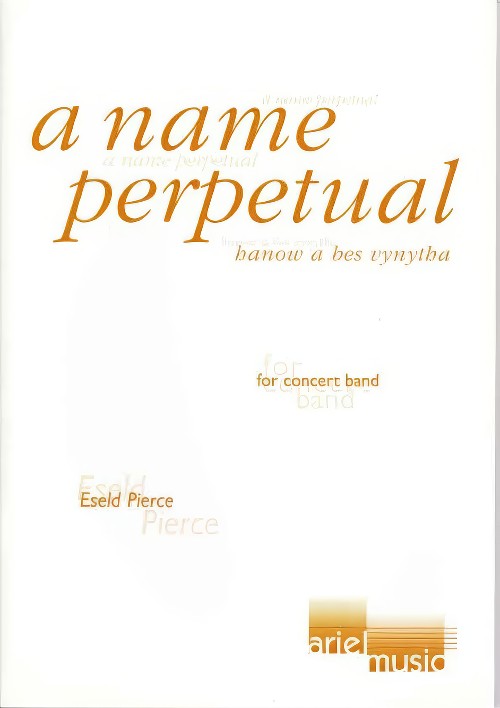Results
-
 £104.99
£104.99Fanfare del Popolo (Concert Band - Score and Parts)
Fanfare del Popolo - fanfare of the people - is a reminder of the terrible periods of fascism and dictatorship in world history. It describes a revolution of the oppressed against the tyrant. The people storm the bastions of the dominion and take their fate into their own hands. This fanfare was commissioned by the Symphonic Band Vorarlberg and its conductor Thomas Ludescher. It is dedicated to all people who currently have to live in countries under dictatorship. This item makes an ideal opening work for any concert. 03:15
Estimated dispatch 7-14 working days
-
 £173.25
£173.25Favor and Treasure
Written for an icon in the band world, "Favor And Treasure" honors Col. John Bourgeois, Director Emeritus of the United States Marine Band, past president of the American Bandmasters Association, president of the John Philip Sousa Foundation, American vice president of the International Military Music Society, mentor and friend. "Favor And Treasure" is based on "John's Theme," a bold, original theme conveying inspirational imagery of excellence, artistry and duty congruous with Col. Bourgeois' distinguished career at the helm of the band to which President Thomas Jefferson gave the title "The President's Own." To honor Bourgeois' affinity for Cajun folk music, the old Cajun waltz, "J'ai Passe Devant Ta Porte" is also used, most prominently in the quasi-zydeco section of the work. Musicians and audience members of all ages will be assuredly affected by the spirit and essence of this extraordinary composition.
Estimated dispatch 7-14 working days
-
 £69.99
£69.99Floriana Wind Band Set (Score & Parts)
The convent of St. Florian was the place of work of the Austrian composer Anton Bruckner. It was in the rural setting of this convent with its marvelloaus church that Bruckner composed many of his great symphonies. St. Florian Choral is Thomas Doss' modest tribute to this great master whose music has left its permanent mark on the composer's musical life. 0:03:00
Estimated dispatch 7-14 working days
-
 £84.99
£84.99Irish Charms Wind Band Set (Score & Parts)
Henk Hogestein has created a calm, yet uplifting arrangement of the famous Irish song Believe Me, if all these Endearing Young Charms. The melody displays the very best of Irish tradition with the words coming from a poem by Thomas Moore about love that goes above and beyond physical beauty. Irish Charms will make a wonderful inspirational interlude at any concert. 0:02:50
Estimated dispatch 7-14 working days
-
 £89.99
£89.99Montana Fanfare (Concert Band - Score and Parts)
This piece was composed as a birthday present for the Austrian conductor Walter Rescheneder to acknowledge the strong support he has given to the composer, Thomas Doss. Doss drew the inspiration for this fanfare from a mountain hike in the Salzkammergut. A powerful fanfare reveals enthusiasm and triumph. It is an exulting feeling and gives boundless freedom to look down into the depths from high up giving a view of the stunning landscape. The main melodic theme represents the feeling of vastness one experiences by taking just one quick glance into the distance. A musical treat! 03:50
Estimated dispatch 7-14 working days
-
 £115.00
£115.00NAME PERPETUAL, A (Concert Band) - Pierce, Eseld
Under the leadership of Michael An Gof and Thomas Flamanck, a Cornish host, sometimes estimated to number as many as 15,000, marched to London in protest against excessive taxation. Arriving at Blackheath, they were attacked by the King's army and defeated, and the two rebel leaders were hung, drawn and quartered. On his way to his death, An Gof stated that he would have "a name perpetual and a fame permanent and immortal". A Name Perpetual tells the story of the Rebellion in four connected scenes. The music includes strong elements of the Celtic music tradition, being structured around an old Cornish folk tune. The first scene introduces fragments of the folk theme and reflects the anguish of the Cornish people. The second scene opens with the folk theme on solo piccolo and, as different instruments enter one by one, the march is depicted with its accumulation of forces en route. The march halts suddenly as the Cornishmen discover the unexpected arrival of the English army and the subsequent music portrays the Blackheath Skirmish. In this scene the orchestra is divided into four parts, each working independently to create a sense of chaos, with the stronger elements of the brass and bass instruments representing the English, while the woodwind and saxophones represent the Cornish, struggling to sustain the folk tune throughout the battle. Eventually all the parts come together and the final section is a lament for the lost Cornishmen, fading away to leave only a haunting off-stage trumpet solo.
Estimated dispatch 7-14 working days
-
 £154.99
£154.99Ouverture Allemande (Concert Band - Score and Parts)
This festive overture by the Austrian composer Thomas Doss, whose father was German, is intended to be a symbol of the friendship between Germany and Austria, and the countries that border on these two states. In times of union and cooperation, the European thinking should be one of tolerance and openness when it comes to national identities and cultures. European culture has many faces - that is what makes it unique. The shadows of the past, however, should never be forgotten, but they must not obscure the present and the future. Many ghosts wander through this overture, and those who listen carefully will also hear a great master of classical music ghost around. A creative new opening work for any concert. 09:00
Estimated dispatch 7-14 working days
-
 £64.35
£64.35Pageant of Light
This great composition is intended to capture the integrity and intensity of Thomas Edison. Opening with an alternating woodwind quintet- brass choir section, it quickly moves into a fanfare and theme exposition. Warm rich harmonies underscore a lyric trumpet solo which begins the slower middle section. EXCELLENT!
Estimated dispatch 7-14 working days
-
 £264.99
£264.99Panoptikum (Concert Band - Score and Parts)
Armin Schaer commissioned this work in his search for a new piece for the tuba. More specifically, he wanted a work that showed off the versatility of this splendid instrument, written in a musical style that is both fresh and modern, while not banishing the orchestra to a simple supporting role. Taking all these specifications into account, Thomas Doss created a work that allows stylistic leaps and is fun, exciting, romantic, and virtuosic, but does not lose sight of the thread that connects the opening measures to the very last.Armin Schaer describes his Panoptikum as follows:Panoptikum is a show of appreciation for my beautiful home and community at Lake Constance, an eventful life, the people that have enriched this life, and a fascinating instrument: the tuba. This work musically embodies the many different moods found around theBodensee - cheerfulness and melancholy, departures and longing, calm and agitation. The roles of the soloist and the orchestra were consciously crafted in a way that does not follow the usual conventions of the genre. The work should spark emotions, address broad segments of listeners, and persuade them of the tuba's ability to be a solo instrument as well as the richness symphonic wind ensembles have to offer. I hope this work enriches the lives of all the soloists and orchestras that cross its path, as well as everyone in the audience who gets to partake! 15:30
Estimated dispatch 7-14 working days
-
 £84.99
£84.99Song of David Wind Band Set (Score & Parts)
This work is based on the 13th Century Dies Irae (Day of Wrath) attributed to Thomas von Celano. Many famous composers have already employed this originally Gregorian chant in their works, including Berlioz, Saint-Sa?ns, Mahler and Lizst. In Jan de Haan's Song of David - the title of which is taken from the third line of the Dies Irae text - the theme is presented in unison initially and then reappears in various guises. 0:03:50
Estimated dispatch 7-14 working days
